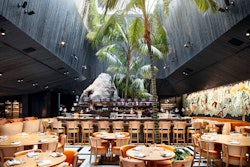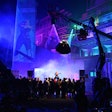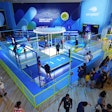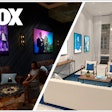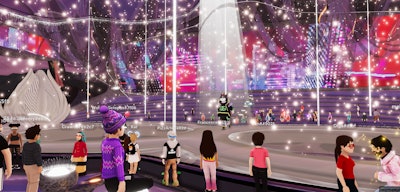
For decades, fashion designers have showcased their collections across a host of iconic venues in cities around the world—from Lincoln Center in New York, to Spazio Cavallerizze in Milan, to Le Grand Palais des Champs-Élysées in Paris. And now, Decentraland.
From March 24-27, high-end maisons along with established and digital-native brands—including Dolce & Gabbana, Tommy Hilfiger, Forever 21, DKNY and Estée Lauder—entered the virtual world to present during the inaugural Metaverse Fashion Week (MVFW). The four-day event featured runway shows, brand activations, interactive experiences, after-parties with performances by artists, including Grimes, and shopping opportunities inside digital storefronts—very much like an IRL fashion week, but with a teleportation element.
Hosted by the Decentraland Foundation, the nonprofit organization that oversees the 3D browser-based platform, MVFW was held inside community-run neighborhoods within the newly created Fashion District, which is owned by Metaverse Group.
The fashion industry has become a prominent early adopter in the metaverse space, with big-name designers setting up shop. For example, the Forever 21 Shop City let users and fashion influencers own and manage stores in Roblox. And Gucci bought a plot of digital land in The Sandbox to expand its online store concept. Not to mention Balenciaga, which partnered with online game Fortnite to sell four signature items from its collection, which served as skin and accessories for avatars.
“I think it's easy for brands to approach and find their own identity in this particular ecosystem,” explains Dr. Giovanna Graziosi Casimiro, head of MVFW, about the industry’s embrace of this burgeoning tech. “I think fashion has been incorporating a lot of different media to express who they are. For example, fashion movies became very popular with fashion brands. So I think extending the narrative of those designers to the metaverse and 3D—that's something that a lot of designers already do actually.”  High-end maisons along with established and digital-native brands, including Dolce & Gabbana, Tommy Hilfiger, Forever 21, DKNY and Estée Lauder, entered the virtual world to present during the inaugural Metaverse Fashion Week.Screenshot: Courtesy of Decentraland
High-end maisons along with established and digital-native brands, including Dolce & Gabbana, Tommy Hilfiger, Forever 21, DKNY and Estée Lauder, entered the virtual world to present during the inaugural Metaverse Fashion Week.Screenshot: Courtesy of Decentraland
For MVFW, Estée Lauder created an NFT wearable based on the brand’s popular serum, Advanced Night Repair. Attendees were able to step inside the product’s iconic “Little Brown Bottle” to unlock a digital badge, or “Proof of Attendance Protocol,” and could also claim an NFT-backed digital wearable that gave their avatars a glowing aura inspired by the serum.
Authentic Brands Group’s Forever 21 rented the equivalent of 450,000 square feet of space within the platform’s fashion district to open a virtual store with avatars acting as sales associates and NFTs of avatar outfits. Guests were able to explore MVFW for free, but in order to buy NFTs or even snag free ones, users needed to set up a blockchain wallet.
On his own Decentraland estate, designer Philipp Plein hosted a runway show and an afterparty with DJs, as well as a see-now, buy-now collection that was available as limited-run NFTs. Held on Plein Plaza, the show featured a metallic skull-shaped animatronic structure from which avatar models appeared to strut their stuff. And Dolce & Gabbana presented an actual “catwalk” with cat-faced avatar models walking down a figure-eight-shaped runway inside a stadium-like space with bleachers. It was standing room only (because the avatars can’t sit, of course).  Rarible Street hosted a temporary space, the Rarible Fresh Drip Zone, inspired by the streets of New York.Screenshot: Courtesy of Decentraland
Rarible Street hosted a temporary space, the Rarible Fresh Drip Zone, inspired by the streets of New York.Screenshot: Courtesy of Decentraland
But being a virtual land owner wasn’t a requirement. With the aim of building a democratized fashion space, Decentraland helped coordinate the construction of the infrastructure for many of the designer showcases.
“Because we're a nonprofit, our goal is not to charge brands to come into Decentraland, but actually facilitate the entrance,” Casimiro says. “That's why we decided to invest and create this event and make it accessible to any brand that wanted.” Casimiro and her team connected brands with the platform’s creators; all of the 3D models of the catwalks, as well as inside the shops, were created by studios within the Decentraland community.
As with any new event—IRL or virtual—MVFW experienced some glitches. Casimiro acknowledges the technical limitations of the platform, especially for an event of this scale, explaining that those are the current growing pains of Web3 and decentralized blockchains.
Despite the hiccups, the platform saw 108,000 unique attendees during the course of the event, with $76,757 worth of wearables sold.
Of course, you can’t put a price on being cool. After collaborating with designers such as Rebecca Minkoff and Christian Cowan on high-tech fashion projects, Yahoo launched its own venue during the event with intentions of utilizing the space for future brand collaborations. For MVFW, the company brought its Electric/City immersive shopping environment into Decentraland with The Initiation: a Charli Cohen x RSTLSS collection. Within the experience, visitors were able to explore a mysterious alien artifact that displayed the wearables, teleport onto the rooftop for a live set by DJ_Dave, visit a sports bar, peruse a gallery of digital art and purchase NFT art as well as NFT wearables from the collection.
“Yahoo has seen huge growth in younger audiences this year, reaching almost two-thirds of Gen Z audiences in the U.S., and we have been innovating in the technology space for quite some time,” explains Joanna Lambert, president and GM at Yahoo, about the brand’s decision to participate in MVFW. “The possibilities are endless as we explore how to create immersive experiences for the next generation. The desire for a combination of both digital and physical engagement is evolving in this ever-changing landscape, and we are really focused on what the experience can be in both the digital and real world.”  Attendees showed off their digital duds at after-parties that included performances by artists like Grimes.Screenshot: Courtesy of Decentraland
Attendees showed off their digital duds at after-parties that included performances by artists like Grimes.Screenshot: Courtesy of Decentraland
As we’ve seen, the pandemic spurred the rise of virtual events and work-from-home culture, prompting some to venture further into the digital fashion closet.
“I think a lot of people realized that maybe I don't need so many clothes when you stay at home,” Casimiro muses. “I think you start understanding that your avatar is an extension of yourself and could be something beyond what you show in the physical space. You can actually be whatever you want to be inside the metaverse.”
Looking ahead, Casimiro says that she envisions MVFW becoming an annual event that’s hosted across other virtual platforms and metaverses, allowing designers and brands to reach an even wider audience. “You can have people from all over the globe watching the show at the same time together. That, I think, is very powerful.”
 With the aim of building a democratized fashion space, Decentraland helped coordinate the construction of the infrastructure for many of the designer showcases.Screenshot: Courtesy of Decentraland
With the aim of building a democratized fashion space, Decentraland helped coordinate the construction of the infrastructure for many of the designer showcases.Screenshot: Courtesy of Decentraland
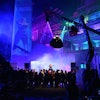




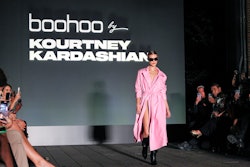
![IMAGE Skincare also held an exclusive gifting suite at the Plymouth Hotel where 150 VIPs were invited to receive a facial courtesy of the brand. Here, there was also a refreshment bar courtesy of POM Wonderful. “Our event stood out due to the fact that it was a true omni-channel experience that left no stone unturned,” Popowystch said. “Everyone who visited [the sunblock party and VIP suite] was able to leave with IMAGE goodies or hands-on experience with the SPF.”](https://img.bizbash.com/files/base/bizbash/bzb/image/2022/07/DSC_1189.62e2b49b9ea28.png?auto=format%2Ccompress&fit=crop&h=167&q=70&w=250)
